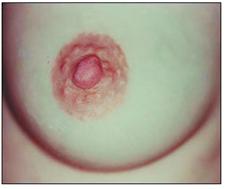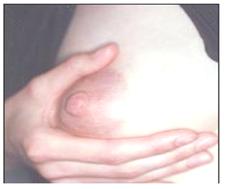분만 후 유방 관리, Postpartum breast cares
- 분만 후 첫 일주일 동안 샤워나 목욕을 보통 때처럼 하되, 젖꼭지와 유두륜(유륜)은 비누로 많이 닦지 않는다.
-
-
살균용(멸균) 비누로 닦아서는 안 된다.
-
젖꼭지와 유륜을 비눗물로 자주 씻으면 피지가 닦여서 젖꼭지와 유륜이 건조해지고 갈라질 수 있고 뻣뻣해 질 수 있기 때문이다.
-
그렇다고 해서 젖꼭지와 유륜에 어느 종류든 연고나 크림을 바르면 접촉성 피부염이 생길 수 있다. 의사의 지시 없이 연고나 크림을 발라서는 안 된다.
-
수유모는 특히 젖꼭지, 유두륜 등 유방에 공기가 잘 유통될 수 있는 브라를 입어야 한다.
-
매번 젖을 먹인 후 5~10분 정도 젖꼭지와 유방을 공기에 일부러 노출시키는 것도 좋다.
-
수유용 패드를 브라 안속에 넣어 자연적으로 분비되는 젖이 패드에 흡수되게 해 젖꼭지와 유방의 위생관리를 잘 하는 것도 잊지 말아야 한다.
-
분만 후 1∼3일 동안 초유가 주로 분비되고 분만 후 2~3일경부터 변이 모유가 분비되기 시작한다.
-
분만 후 2~3일 이후부터 변이 모유가 분비되기 시작해서 4~5일경부터는 성숙 모유가 정상적으로 분비되기도 한다. 이때부터 아기가 먹을 수 있게 젖이 충분하게 분비된다.
-
이 때 ‘유방 과잉 충만(Breast engorgement)’ 현상이 생길 수 있다. 젖이 먹고 남을 정도로 충분히 분비되기 시작 한다.
-
유방의 혈액순환이 왕성해지고 유방이 커져 얼얼하거나 아픈 증상 징후가 생기는 현상을 유방 과잉 충만 이라 한다. (p00 유방 과잉 충만 참조)
-
유방 과잉 충만은 다른 말로 ‘젖몸살’이라고도 한다. 유방 과잉 충만이 생기면 뭉클뭉클한 젖 덩어리가 유방 전체 속에 생기고 젖이 젖꼭지에서 자연적으로 흘러나올 수 있다. 대개 분만 후 2~3일경부터 모유 분비가 현저하게 늘어나면서 생긴다. 유방 과잉 충만은 24~48시간 동안 계속될 수 있다.
-
유방 과잉 충만이 있으면 유방이 무겁고 아프고 불편하다.
-
이 때 몸에 알맞은 브라로 유방을 잘 받쳐주면 유방이 덜 불편할 수 있다.
-
이 기간 동안에는 2~3시간마다 젖을 먹인다. 매번 젖을 먹이기 직전 유방 전체를 손으로 마사지하면 유방 전방부분의 젖과 유방 후방부분의 젖이 유방 속에서 섞여 유방에 생긴 젖멍울이 더 잘 풀린다.
-
수유모의 유방도 덜 아프고 젖도 더 잘 나온다.
-
이렇게 마사지를 해주면 유방 과잉 충만으로 인한 불편이 한결 덜하다.
-
유방 과잉 충만이 있을 때는 유두륜의 바로 아래 유방조직에 있는 유동 속에 젖이 충만해져 유두륜 부분도 통통해질 수 있다.
-
이 때 아기를 부적절한 자세로 안거나 젖꼭지를 아기의 입안에 적절히 물리지 않으면 젖꼭지가 수유 중 몹시 아플 수 있다.
-
특히 유방 과잉 충만 현상이 있을 때는 매번 모유를 먹인 후 먹다 남은 유방 속에 괸 젖을 손으로 짜내는 것이 좋다. 손으로 잘 짤 수 없으면 유축기로 젖을 짜낸다.
-
분만 후 산후회복, 산후조리를 잠시 동안 한 후 병원 산실에서 집으로 퇴원한 이후 모유수유를 하는 동안 문제가 생겼을 때 도움을 요구할 수 있는 간호사, 라 레체 기구 요원, 모유수유 전문가, 모유수유 전문의들의 주소나 전화번호 등을 알아놓았다가 필요할 때 그들의 전화 상담 도움을 받는다.
-
분만 후 병원 산실에서 집으로 퇴원한 대부분의 산모들은 임신, 분만, 산후회복, 산후조리 등으로 밀린 가사, 매일 해야 할 잡일, 아기 돌보기와 양육 등으로 매우 바쁜 시간을 보낸다.
-
그러나 적어도 산후 몇 주 동안은 정신적·육체적으로 충분히 휴식을 충분히 취하는 것이 중요하다.
-
수유모는 될 수 있으면 주로 아기를 돌보고 분만 후 모유수유를 하는 데만 전심을 쏟아야 한다. 그 밖의 대부분의 가사는 다른 사람들에게 맡겨야 한다.
-
산모는 임신 및 분만에서 오는 정신적·육체적 피로, 엄마의 역할, 호르몬의 분비, 경제적 문제, 부부 관계, 사회 활동 제한, 육체적 변화 등으로 이미 정신적으로 큰 스트레스를 받고 있는 상황에 있다.
-
이런 저런 이유로 산후 블루나 산후 우울증이 생길 수 있다. 이때 유방 과잉 충만은 수유모에게 한층 심한 스트레스를 주게 된다.
-
따라서 다른 어느 때보다 아기 아빠를 비롯해 집안 식구나 다른 사람들, 때로는 의사의 도움이 절실히 필요하다.
-

사진 4-50. 모유는 데우지 않아도 언제든지 바로 먹을 수 있게 온도가 적절하다. 유륜에 나 있는 몽고메리 돌기가 선명하게 보인다.
Copyright ⓒ 2011 John Sangwon Lee, MD., FAAP

사진 4-51.젖이 퉁퉁 불어 유방 과잉 충만이 생기면 수유모는 불편함을 느낄 수 있다.
Copyright ⓒ 2011 John Sangwon Lee, MD., FAAP
Postpartum breast cares 분만 후 유방 관리
During the first week after delivery, take a shower or bath as usual, but don’t clean your nipples and nipple rings (areolas) much with soap.
Do not wipe with sterilizing (sterile) soap.
This is because frequent washing of the nipples and areolas with soapy water wipes the sebum, which can lead to dryness, cracking, and stiffness of the nipples and areolas.
That said, applying any kind of ointment or cream to your nipples and areolas can lead to contact dermatitis.
Do not apply ointments or creams without your doctor’s instructions.
Nursing mothers should wear bras that allow air to flow well through the breasts, especially nipples and nipple rings.
It is also good to deliberately expose your nipples and breasts to the air for 5 to 10 minutes after each breastfeeding.
Don’t forget to put a nursing pad inside your bra so that the naturally secreted milk is absorbed by the pad, so that your nipples and breasts are well maintained.
Colostrum is mainly secreted for 1-3 days after delivery, and transitional breast milk begins to secrete around 2-3 days after that.
From 2 to 3 days after delivery, transitional breast milk begins to be secreted, and mature breast milk is normally secreted from 4 to 5 days after delivery. From this point on, enough milk is secreted for the baby to eat.
This can lead to breast engorgement.
It begins to secrete enough to leave the breast milk to eat.
A phenomenon in which blood circulation in the breast becomes vigorous and the breast becomes enlarged, causing tingling or painful symptoms, is called breast overfilling. (See Breast Excess Fullness)
In other words, overfilling of the breast is also referred to as milk body aches’. When overfilling of the breast occurs, a lumpy milk mass can form throughout the breast and the milk can flow out naturally from the nipple. It is usually caused by remarkably increasing breast milk secretion from 2 to 3 days after delivery.
Breast overfilling can last for 24 to 48 hours. If there is an overfilling of the breast, the breast is heavy, painful, and uncomfortable.
At this time, if the breast is well supported with a bra suitable for the body, the breast may be less uncomfortable. During this period, breastfeed every 2-3 hours. If you massage the entire breast by hand just before feeding each time, the breast milk from the front part of the breast and the milk from the back part of the breast are mixed in the breast to relieve the breast lumps.
The breast of the nursing mother hurts less and the milk comes out better.
This massage will reduce the discomfort caused by overfilling the breast. When the breast is overfilled, the fluid in the breast tissue just below the nipple ring becomes full of milk, which can also cause the nipple ring to become plump.
At this time, if the baby is held in an inappropriate position or the nipple is not properly bitten in the baby’s mouth, the nipple can become very painful during lactation. In particular, when there is an overfilling of the breast, it is good to squeeze the breast milk into the remaining breast after each breastfeeding.
If you can’t express well by hand, use a pump to express your milk. Addresses of nurses, La Leche agents, breastfeeding experts, and breastfeeding specialists who can ask for help when problems arise while breastfeeding after postpartum recovery and postpartum care after delivery for a while and then discharged from the hospital’s birth room.
Get their phone number, etc., and get their phone help when needed. Most of the mothers who are discharged home from the hospital’s birthing room after delivery spend a very busy time due to pregnancy, delivery, postpartum recovery, postpartum care and other chores, daily chores, baby care, and childcare.
However, it is important to get enough rest both mentally and physically for at least a few weeks after childbirth.
Whenever possible, nursing mothers should devote all their heart to taking care of the baby and breastfeeding after delivery.
Most of the other lyrics should be left to others. Mothers are already in a situation where they are under significant mental and physical stress due to mental and physical fatigue from pregnancy and childbirth, mother’s role, hormone secretion, economic problems, marital relations, social activity restrictions, and physical changes.
For one reason or another, postpartum blues or postpartum depression can occur.
At this time, excessive breast filling puts more stress on the nursing mother. Therefore, more than ever, breastfeeding moms need help from fathers, families, other people, and sometimes doctors.

Photo 4-50. Breast milk is at an appropriate temperature so that it can be eaten at any time without warming up. The Montgomery projection on the areola is clearly visible. Copyright ⓒ 2011 John Sangwon Lee, MD., FAAP

Photo 4-51. If the breast is swollen and the breast is overfilled, the nursing mother may feel uncomfortable. Copyright ⓒ 2011 John Sangwon Lee, MD., FAAP
출처 및 참조 문헌
- NelsonTextbook of Pediatrics 22ND Ed
- The Harriet Lane Handbook 22ND Ed
- Growth and development of the children
- Red Book 32nd Ed 2021-2024
- www.drleepediatrics.com 제1권 소아청소년 응급 의료
- www.drleepediatrics.com 제2권 소아청소년 예방
- www.drleepediatrics.com 제3권 소아청소년 성장 발육 육아
- www.drleepediatrics.com 제4권 모유,모유수유, 이유
- www.drleepediatrics.com 제5권 인공영양, 우유, 이유식, 비타민, 미네랄, 단백질, 탄수화물, 지방
- www.drleepediatrics.com 제6권 신생아 성장 발육 육아 질병
- www.drleepediatrics.com제7권 소아청소년 감염병
- www.drleepediatrics.com제8권 소아청소년 호흡기 질환
- www.drleepediatrics.com제9권 소아청소년 소화기 질환
- www.drleepediatrics.com제10권. 소아청소년 신장 비뇨 생식기 질환
- www.drleepediatrics.com제11권. 소아청소년 심장 혈관계 질환
- www.drleepediatrics.com제12권. 소아청소년 신경 정신 질환, 행동 수면 문제
- www.drleepediatrics.com제13권. 소아청소년 혈액, 림프, 종양 질환
- www.drleepediatrics.com제14권. 소아청소년 내분비, 유전, 염색체, 대사, 희귀병
- www.drleepediatrics.com제15권. 소아청소년 알레르기, 자가 면역질환
- www.drleepediatrics.com제16권. 소아청소년 정형외과 질환
- www.drleepediatrics.com제17권. 소아청소년 피부 질환
- www.drleepediatrics.com제18권. 소아청소년 이비인후(귀 코 인두 후두) 질환
- www.drleepediatrics.com제19권. 소아청소년 안과 (눈)질환
- www.drleepediatrics.com 제20권 소아청소년 이 (치아)질환
- www.drleepediatrics.com 제21권 소아청소년 가정 학교 간호
- www.drleepediatrics.com 제22권 아들 딸 이렇게 사랑해 키우세요
- www.drleepediatrics.com 제23권 사춘기 아이들의 성장 발육 질병
- www.drleepediatrics.com 제24권 소아청소년 성교육
- www.drleepediatrics.com 제25권 임신, 분만, 출산, 신생아 돌보기
- Red book 29th-31st edition 2021
- Nelson Text Book of Pediatrics 19th- 21st Edition
- The Johns Hopkins Hospital, The Harriet Lane Handbook, 22nd edition
- 응급환자관리 정담미디어
-
소아가정간호백과–부모도 반의사가 되어야 한다, 이상원
-
Neonatal Resuscitation American heart Association
-
Neonatology Jeffrey J.Pomerance, C. Joan Richardson
-
Pediatric Resuscitation Pediatric Clinics of North America, Stephen M. Schexnayder, M.D.
-
Pediatric Critical Care, Pediatric Clinics of North America, James P. Orlowski, M.D.
-
Preparation for Birth. Beverly Savage and Dianna Smith
-
Infectious disease of children, Saul Krugman, Samuel L Katz, Ann A. Gershon, Catherine Wilfert
- Pediatric Nutritional Handbook American Academy of Pediatrics
- 소아가정간호백과–부모도 반의사가 되어야 한다, 이상원
- The pregnancy Bible. By Joan stone, MD. Keith Eddleman, MD
- Neonatology Jeffrey J. Pomerance, C. Joan Richardson
- Preparation for Birth. Beverly Savage and Dianna Smith
- 임신에서 신생아 돌보기까지. 이상원
- Breastfeeding by Ruth Lawrence and Robert Lawrence
- Infectious disease of children, Saul Krugman, Samuel L Katz, Ann A. Gershon, Catherine Wilfert
- The Harriet Lane Handbook 19th Edition
- 제4권 모유, 모유수유, 이유 참조문헌 및 출처
- 제5권 인공영양, 우유, 이유, 비타민, 단백질, 지방 탄수 화물 참조문헌 및 출처
- 제6권 신생아 성장발육 양호 질병 참조문헌 및 출처
- 소아과학 대한교과서
- 그 외
|
Copyright ⓒ 2015 John Sangwon Lee, MD, FAAP 미국 소아과 전문의, 한국 소아청소년과 전문의 이상원 저 “부모도 반의사가 되어야 한다”-내용은 여러분들의 의사로부터 얻은 정보와 진료를 대신할 수 없습니다. “The information contained in this publication should not be used as a substitute for the medical care and advice of your doctor. There may be variations in treatment that your doctor may recommend based on individual facts and circumstances. “Parental education is the best medicine.” |